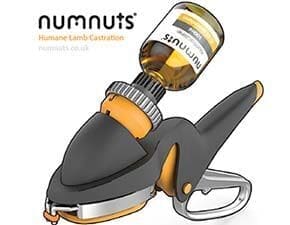 AUSTRALIA’S new pain relief technology for the castration of lambs and calves – Numnuts – needs a commercial partner to help fund its $1 million commercialisation price tag.
AUSTRALIA’S new pain relief technology for the castration of lambs and calves – Numnuts – needs a commercial partner to help fund its $1 million commercialisation price tag.
The new Numnuts technology will be ready for on-farm use in 18-24 months and industry funding is available for commercialisation.
MLA is now seeking a joint venture partner to commercialise the product.
NumNuts was developed by Meat & Livestock Australia and Scottish engineering firm 4cDesign.
It incorporates a single action hand-held ring activator and injection mechanism to administer a local anaesthetic – lignocaine, as used by the dental industry – to quickly and effectively reduce pain.
It is hoped Numnuts will cost around 20c per treatment for lambs aged two to 12 weeks – the recommended age for marking lambs under the new Australian Animal Welfare Standards and Guidelines.
The development of Numnuts also had contributions from Australian Wool Innovation, the Moredun Research Institute in Scotland and CSIRO, and is currently in the commercialisation process.
Proof-of-concept trials for a cattle castration version of Numnuts and Minimum Residue Level research for lignocaine are also underway. The current Numnut applicator for sheep can cope with a ring for a three-month-old calf, but no cost estimate is available for calves.
However, MLA Program Manager, Animal Health, Welfare and Biosecurity, Dr Jim Rothwell, said MLA was still looking for an investor to scale up commercialisation and manufacturing.
He said there had been some interest from potential investors but none had been signed.
“We’re not talking a lot of money and we can double the money through the MLA Donor Company.
“We need an investor who genuinely has an interest in this welfare space to come on board.”
MLA is looking for an investor willing to part-fund an estimated commercialisation cost of $1million and sign a standard licensing agreement with royalties on international sales.
“We think to get this thing through to the marketplace and ready to use it is going to cost less than $1million and we can match half of that with the MLA Donor Company.”
“We are not talking about a lot of money.”
Market assurance benefits
Dr Rothwell said there will be market quality assurance advantages for sheep and cattle producers using Numnuts in the medium term, helping them to meet future export requirements.
“I have no doubt they will… the new Australian Animal Welfare Standards and Guidelines for sheep are coming.
“They call for the use of husbandry pain relief for surgical practices on animals more than six months old and they recommend their use if they are available in general,” he said.
“We are also in a competitive environment with other livestock product countries, so having tools available to improve the welfare standards of Australian livestock is going to beneficial in the long term.”
He said the Numnuts technology will allow farmers to potentially get price premiums by meeting market animal welfare quality assurance expectations. The sheep welfare guidelines state that pain relief is desirable, if practical and cost effective for lambs at marking, and it is required for animals over six months of age.
Numnuts for lamb tail-docking
Dr Rothwell said Numnuts will also give producers options for the tail-docking of lambs, superior to the use of a hot knife.
“It is extremely effective on tail docking; the pain relief is almost immediate.
“It is effective on testicles as well, though the onset of pain relief is slower than for tails.”
Dr Rothwell said calves and lambs treated with Numnuts were likely to be less stressed and would mother up more quickly.
Proof-of-concept trials have shown serious reductions in pain behaviour such as ‘tucked up’ posture, bleating and lying down when lambs are treated using the Numnuts tool. The anaesthetic acts within 30-60 seconds of injection and remains active for about four hours by which time the tissue in the testes and tail is dead, eliminating residual pain.
Dr Rothwell said the NumNuts applicator is simple and effective, and easily used by producers to achieve excellent gains in animal husbandry.
“Our research has demonstrated the ability of this tool to very rapidly reduce pain throughout husbandry processes that are important to both production and broader animal safety.
“The NumNuts tool will allow producers to administer effective pain relief in a safe, controlled and fast-acting manner without the need for a veterinarian to be present, making it a practical and economically viable option for on-farm use,” he said.
“We know happy animals are productive animals and this new technology shows the proactivity and willingness across the sector to continually seek to innovate in the area of animal welfare and to embrace best practice.”
Minimum Residue Limit research is ongoing
General Manager of On-Farm Innovation and Adoption Dr Matt McDonagh said Numnuts is a great example of levy payer funds being invested in research and development to deliver a practical on farm tool for sheep producers and proof-of-concept trials are now underway for a cattle castration version of NumNuts. MLA is also funding research to set the minimum residue levels of lignocaine, which will determine any meat withholding period, he said.
Dr Rothwell said the Numnuts research on calves is being undertaken on three-month-old dairy bulls in Scotland and behavioural videos and assessments are being analysed now.
“The single midline injection is effective in bull calves; it will be animals less than six months of age.”
Live calf testing will also undertaken in Australia
Dr Rothwell said the live phase of the cattle proof-of-concept trials has been completed and data is being analysed to help determine MRLs and meat withholding periods. There has also been some “good involvement” with the APVMA.
- Click here to view a short Twitter video demonstrating the use of the Numnuts applicator.

